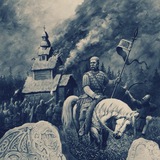This media is not supported in your browser
VIEW IN TELEGRAM
Cowbells
One of the few remaining European cowbell masters from Romania, who still makes them by hand.
@bobb11_oficial on Instagram
One of the few remaining European cowbell masters from Romania, who still makes them by hand.
@bobb11_oficial on Instagram
❤26👍5
Forwarded from Kyle Davis
~ GALDR ~
The practice of Galdr involves the chanting of verses to achieve a certain outcome, based on whether the Gods join you in the singing. The reverberation of the chant is pivotal to the development of a proper Galdr and must be taken into consideration when performing it.
There are three types of Galdr we will present here, to give the full spectrum of the record involving this practice.
First are the Direct Galdr, which are the verses in Galdralag meter that are in the sources and can be connected to a specific working.
Then there is the Chronicled Galdr, which are the chants given in a specific poem that are not in the Galdralag meter, but which are specifically stated to be a chant given. It should be noted that while these verses are not Galdralag, they are still in Ljóðahattr meter, from which Galdralag is formed. In fact, when we learn about the sanctity of Galdralag in Ynglingasaga, it is directly connected to the ljóða:
Allar þessar íþróttir kendi hann með rúnum ok ljóðum, þeim er galdrar heita; fyrir því eru Æsir kallaðir
galdrasmiðir.
“All these feats he taught with rúnar and ljóða, those which are called Galdr, and because of this the Æsir are called Galdr-smiths”.
….(please follow the link below)
https://norroena.org/galdr/
The practice of Galdr involves the chanting of verses to achieve a certain outcome, based on whether the Gods join you in the singing. The reverberation of the chant is pivotal to the development of a proper Galdr and must be taken into consideration when performing it.
There are three types of Galdr we will present here, to give the full spectrum of the record involving this practice.
First are the Direct Galdr, which are the verses in Galdralag meter that are in the sources and can be connected to a specific working.
Then there is the Chronicled Galdr, which are the chants given in a specific poem that are not in the Galdralag meter, but which are specifically stated to be a chant given. It should be noted that while these verses are not Galdralag, they are still in Ljóðahattr meter, from which Galdralag is formed. In fact, when we learn about the sanctity of Galdralag in Ynglingasaga, it is directly connected to the ljóða:
Allar þessar íþróttir kendi hann með rúnum ok ljóðum, þeim er galdrar heita; fyrir því eru Æsir kallaðir
galdrasmiðir.
“All these feats he taught with rúnar and ljóða, those which are called Galdr, and because of this the Æsir are called Galdr-smiths”.
….(please follow the link below)
https://norroena.org/galdr/
❤12
Forwarded from Pagan Revivalism
Join us live for a 2nd Anniversary stream as we go over the past year and what's to come for Pagan Revivalism!
https://www.group-telegram.com/Pagan_Revivalism?livestream
https://www.group-telegram.com/Pagan_Revivalism?livestream
❤22👍2
Forwarded from European Identity
"Nor are the women hurried early into marriage: the same age and the same full growth is required for both husband and wife: as a result the two sexes unite equally matched and physically healthy; and so the children inherit this strength from their parents."
- Roman historian Tacitus on the virtuous sexual morality of the Germanic Pagans his "Germania" 98 AD
- Roman historian Tacitus on the virtuous sexual morality of the Germanic Pagans his "Germania" 98 AD
❤47👍4
Forwarded from Aryan Paganism, Traditions and Art (APTA)
Do I not then deservedly detest all you philosophers…men whom not only did Lysimachus the king banish from his own dominions, as Carystius tells us in his Historic Reminiscenses, but the Athenians did so too. At all events, Alexis, in his Horse, says:
Is this the Academy; is this Xenocrates?
May the gods greatly bless Demetrius
And all the lawgivers; for, as men say,
They’ve driven out of Attica with disgrace
All those who do profess to teach the youth
Learning and science.
Athenaeus of Naucratis
Is this the Academy; is this Xenocrates?
May the gods greatly bless Demetrius
And all the lawgivers; for, as men say,
They’ve driven out of Attica with disgrace
All those who do profess to teach the youth
Learning and science.
Athenaeus of Naucratis
👍11❤1
Forwarded from Aryan Paganism, Traditions and Art (APTA)
Media is too big
VIEW IN TELEGRAM
Kupala
👍11
Forwarded from Aryan Paganism, Traditions and Art (APTA)
Loki’s daughter is not clearly identified as Hel in any of the existing Eddaic poems. In light of this, it’s important to note that the description of “Hel’s high hall” stands in stark contrast to the hall of Loki’s daughter in Snorri’s Edda.
In the Eddaic poem Baldrs Draumar, whereas the benches in “Hel’s high hall” are strewn with costly things and mead stands poured out in goblets awaiting a guest, the hall of Loki’s daughter (whom Snorri calls Hel) is a dismal place with its dish called “Hunger” and its knife named “famine.”
The Eddaic poems clearly distinguish this place from Hel, the realm where “all men” must eventually come according to Fáfnismál 10.
W.P. Reaves
In the Eddaic poem Baldrs Draumar, whereas the benches in “Hel’s high hall” are strewn with costly things and mead stands poured out in goblets awaiting a guest, the hall of Loki’s daughter (whom Snorri calls Hel) is a dismal place with its dish called “Hunger” and its knife named “famine.”
The Eddaic poems clearly distinguish this place from Hel, the realm where “all men” must eventually come according to Fáfnismál 10.
W.P. Reaves
👍13❤1
